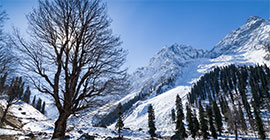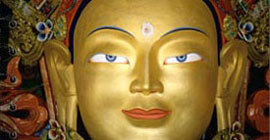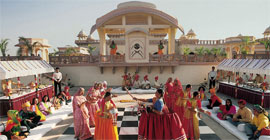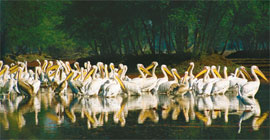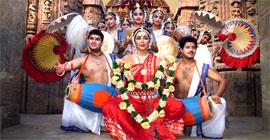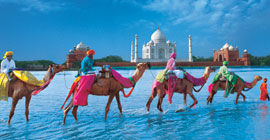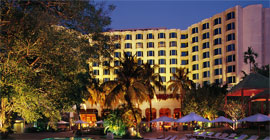shekhawati
Home | Shekhawati
Lachhmangarh
Founded in the early 19th century by Raja Lachhman Singh of Sikar, this town is planned on the lines of Jaipur, with roads at right angles and roundabouts. The grant Char Chowk Haveli is reminiscent of the prosperous Marwari way of life. The fort, Sawant Ram Chokhani Haveli, Mirijamal Kyala Haveli, Bansidhar Rathi Haveli, Kedia Haveli and Sanganeria Haveli adorned with beautiful frescoes.
Churi Ajitgarh
This town is known for the several erotic frescoes painted behind doors, on the bedrooms ceilings and on the walls. Considering the social constructions of that time, these appear to have been the result of a very private and special efforts. Some examples of fine fresco work are evident in the Shiv Narain Nemani Haveli, Shiv Narain Nemani Baithak, Kothi Shiv Datt, Rai Jagan Lal Tibrewal Haveli and Ram Pratap Nemani Haveli.
Fatehpur
Founded in the mid 15th century by a Kayamkhani Nawab, Fatehpur's frescoes are unrivalled. The ones done on the walls on the Devra and Singhania Havelis, splendidly combine Indian and Western styles. These carry inimitable mirror work at the entrance ways, with Japanese tiles carrying Mount Fuji's paintings. The Ram Gopal Mahavir Prasad Goenka Haveli, Hukmi Chand Choudhri Haveli, Jalan and Bharatiiya Haveli are well worth a visit.
Ramgarh
This town was founded in the late 18th century by the Poddars. The dome of the Poddar cenotaph carries exquisitely painted scene from the Ramayana. The devotedly painted frescoes on the Shani-ji (Saturn) temple are splendid. Worth seeing are also the Ganga temple, Tara Chand Ghanshyam Das Poddar Haveli, Baij Nath Ruia Haveli and Bagaria Haveli.
Mandawa
One on the most finest of the small towns in the Shekhawati region, this feudal settlement not only has a royal castle, but innumerable havelis where the painted facades offer a great variety of surprises. Mandawa was founded by Thakur Nawal Singh, a descendant of Rao Shekha after whom the entire region is named. It is today also a major center of a handicrafts and furniture industry. A painted archway decorated with Lord Krishna and his cowherds leads to the Bazar. The Mandawa Family's collection includes ceremonial costumes and precious arms with handles of jade. The havelis worth visiting are those of Chokhani, Saraf, Goenka and Ladia.
Lohargal
Lohargal is also a place of tourist because of its natural beauty. This place is associated with Bhim, one of the heroes of the great epic, 'Mahabharat'.
Harsha
Harsha is an ancient village at the base of a hill on which Harshanatha and other temples are located in Sikar district situated around 14 km from Sikar town. Harsha is known for its famous Shiva temple dating back to the Chauhan period. There is a 10 km. long road which leads one to the mountain, from where one can behold the natural beauty of the villages below. There are several temples at Harsha, chief among them being the Harsha temple. From the inscription found at the sanctum of the temple, it is evident that it was built by the Chauhan ruler of Ajmer, Vigrahraj and several changes were made in the temple with the passage of time. Although the temple is now in ruins, one can easily make out that it was once quite unique.
Mukundgarh
Founded in the mid 18th century by Raja Mukund Singh, this is a small town, only 14 km from Mandawa and 2 km from Dundlod in the Shekhawati region. Built around a temple square, Mukundgarh has a good handicraft market. Besides textiles, the brassware and iron scissors made here are of good quality. The Kanoria and Ganeriwala Havelis carry fine examples o fresco paintings. The Mukundgarh has been converted into a heritage hotel and in its conversion into heritage property, Cross Country Hotels has retained the atmosphere this 250 years old fort with its charming, painted interiors that include the typical Shekhawati frescoes.
Dundold
One of the principal feudal principalities of Shekhawati, the havelis of this charming small town are beautifully painted, and some of them are over two hundred years old. These include the Goenka Haveli that is well known for the exquisite quality of its frescoes.
Nawalgarh
The seat of the Poddar families, among other, Nawalgarh is known for the high quality of its paintings, even in the richly frescoed Shekhawati area. Its Poddar School has some excellent old work, as well as walls that have been restored in recent times using the same style of frescos for which the region is famous. Nawalgarh was founded in 1737 by Thakur Nawal Singh, a warrior-statesman of some eminence. The town has a colourful bazaar and a fort, now a little disfigured, yet worthy of attention. There are numerous havelis; prominent among them are the Aath (eight) Haveli Complex, Anandilal Poddar Havlei, Jodhraj Patodia Havlei, Bansidhar Bhagat Haveli, Chokhani Haveli and Hotel Roop Niwas Palace.
Baggar
Located strategically at a cross-road, Baggar has large reservoir built by the Ojha family. Founded in the 15th century by the Nagar Pathans, Baggar was home for the Rungtas and Piramals.
Chirawa
Lying at a cross-road, Chirawa became popular as a trading town between Jhunjhunu and Loharu. The Havelies worth seeing here are Raj Bahadur Tulsian Haveli, Nemani Haveli, Mangal Chand Dalmia Haveli, Tara Chand Keshar Dev Dalmia Haveli, Dulichand Kakrania Haveli, Bhola Ram Kakrania Haveli, Manohar Lal Vaidh Haveli, Karkranida Well and Sekhsaria Well. The Dalmias & Kakraniyas grew wealty on trade and built sprawling havelis here.
Surajgarh
The 18th century fort, in a dilapidated condition and the painted temples and havelis here are the main attraction.
Kajra
The 19th century havelis of the Kajaria family are monuments are worth seeing.
Alsisar & Malsisar
Located on the northern most tip of Shekawati, these towns were founded in the late and mid 18th centuries respectively. The style of the frescoes here and lively colour combinations are a treat for the eyes. Also the forts in Alsisar & Malsisar, as well as the temples and the Jhunjunwala havelis are magnificent. Besides painted havelis, wells and reservoir with ornamental traditional architecture are worth seeing in both the villages.
Bissau
Founded in the 18th century, this town has fine havelis including the Sigtia, Khemka, Tibriwal and Kedia Havelis. The chhatris or cenotaphs of the Thakurs are also attractive.
Khetri
Founded in the 18th century, Khetri was the second wealthiest Thikana under Jaipur and is known for the painting adorning the Raghunath Temple and the Bhopalgarh Fort. Sites not be missed are the Panna Lal Shah ka Talab (water tank), Rama Krishna Mission, Sukh Mahal and Hari Singh Temple. Ajit Sagar, Rameshwar Das Baba ka Ashram at Bassi and Baghore Fort constitute the excursions one can take from here.
Mahensar
This 18th century town has some fine havelis such as the Sona-Chandi-Ki-Sal and business shops built by the Poddars. The Meenakari work, the figures of birds and floral and tree motifs, as well as the gilded walls and ceilings leave the spectator amazed. Raghu Nath Temple is another interesting place to visit.
Parasrampura
Parasrampura is a short excursion from Nawalgarh. Here, some of the earliest frescoes dating back to 1750 are painted in the interior of a temple and on the dome of the Chhatri dedicated to Sardul Singh, a descendant of the founder of the Shekhawati, Rao Shekhaji.







